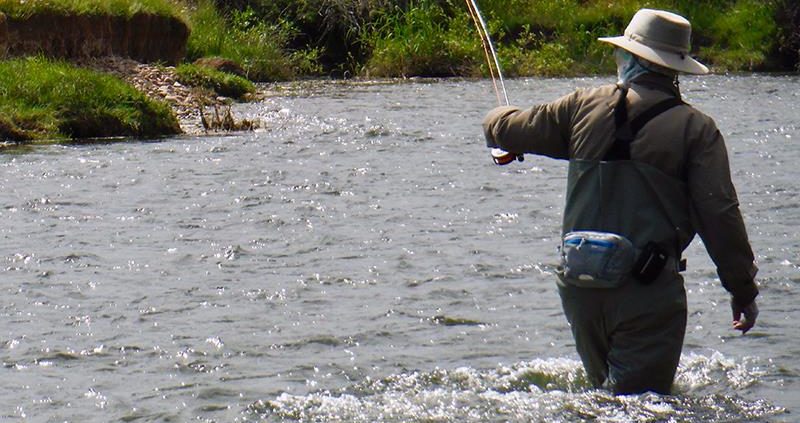Streamer Fishing Suggestions
Streamer Fishing Suggestions
For Salt Greys: Use a floating line with a 9′ custom-made Fluorocarbon leader. Or, use a 10′ Fast-Sink tip with a 4′ custom- made Fluorocarbon leader.
Option 1: Use 1 fly on 15 lb. test. For the Zoo Cougar or Dayle1 s Devil, tie the fly on with a non-slip loop knot and put a size 2 BB just in front of the knot.
Option 2: Tie on a JJ Special or other weighted streamer on the 20 lb. end of your leader and add a Zoo or Devil 2 feet back on 15 lb. test. Tie the 15 lb. test to the hook bend of the top fly.
Option 3: Use a double surgeon’s knot to connect your 15 and 20 lb. test. Leave a long – (1 foot) tag end to your 20 lb. test. Tie a heavier fly like aJJ or Double Bait. Fish to the 15 lb. bottom section and a Zoo or Devil to the top section.
THOUGHTS AND IDEAS:
Floating: On the Snake and South Fork, you might use a 28′ or Full Sink line.
Option 1: Throw to the bank. Slap the fly as close as you can to structures and retrieve in quick strips – watch for the following fish. Experiment as to what retrieve they want.
Option 2: Throw to the bank and let the fly work downstream with the boat. Impart small twitches to the fly as it runs parallel with the bank,
Option 3: When flows get really low in October, drift the banks and throw to the middle of the channel where there is a structure (big rocks). Let the line sink as it travels parallel to the boat. When it reaches the bottom, begin retrieving in strips with pauses. Sometimes the fish will take it almost dead drift, other times they want it stripped as fast as you can
Upstream Wading: Generally, when wading upstream you can get more depth with your fly than you can wade downstream. You can throw your line up and across and let it sink before retrieving. The problem is that for water directly upstream your position, you must retrieve almost directly downstream and your line lands on the fish’s position. I like upstream wading if most of the deeper holding water is on the opposite side, or I can continually cross the stream so that it is. As a right-handed caster, it is considerably easier to wade the left bank and cast to the right bank.
Downstream Wading: Overall, a better situation! I find that keeping the fly at right angles to the current seems to work best. By doing this you will place line and at right angles, from your fly and the retrieve will be at right angles to the current. Continually mend downstream, moving your rod farther away from where you initially landed your fly. By doing this you can run your fly all the way back to your bank keeping the fly at right angles to the current. You can also cast upstream and to the opposite bank and then mend down to keep your fly going parallel to the bank.
CASTING TIPS:
- Use as little back cast as
- “Shoot” line – this is especially important with a shooting head or sink-tip line.
- Learn the Belgian cast. This back-cast is side-armed and the forward cast goes from that position to an overhand forward cast. You don’t stop at the back-cast but continue forward immediately. This method reduces the “clunk” you get as the heavy fly and line hits the end of the back-cast which in turn creates a “rebound” effect which collapses the back-cast and kills the load in the rod prior to the forward
- Learn sophisticated roll casts for pick-up and delivery of heavy flies and sinking lines. (This cast is also extremely helpful when casting with a wind blowing toward your casting) If you need help, call me for a casting lesson. If you already cast a normal line reasonably well, you will learn the basics of these casts in an hour.
- When floating, you should be doing only a pickup, 1 back-cast, and then boom – shoot it. If you have questions or comments, give me a call!
Zoo Cougar– Designed in the Midwest to mimic the sculpins found in almost all trout waters. This fly has been very effective on all of our local rivers. It doesn’t fish deep, so you may want to add weight to your leader or use a sink-tip line. The Zoo takes a lot of fish when it is sitting still, only fluttering in the current. Because of its light color, you can see it – which allows you to track it visually.
LL Special- Designed by Jim Johnson of Jackson Hole, this fly has been a great fly when floating IN local rivers. I tie it with a lot of weight so it really gets down. Fishing it with a pulsing action gives the yellow rubber legs a lot of action. The profile is also that of a sculpin. I use it a lot in front of a Zoo to get the Zoo down. Fish hit either fly.
Dayle’s Devil- Basically, a take-off on a Dahlberg Diver. This is a very realist adult sculpin imitation as to profile and color. Like the Zoo, you won’t believe how much action this fly has. Also like the Zoo, it needs weight to get down. This is my best fly on rocky stretches of the local rivers – where lots of sculpins live.
Dayle’s Double-Bait Fish– This is the fly I use to get to the big browns on the Salt and the South Fork. It works on big cutthroats as well. It is heavier and bigger. Its silhouette and color in the water are very much like a white fish or small Cut. I have had big browns come out of cover 10′ away to nail this fly. Over the past 2 years, I have caught over 15 browns legitimately bigger than 20″ on this fly. The biggest was 26″ and 8.5 lbs. I like to put this at the end of the double surgeon’s rig, with a Zoo up front. Big browns can’t stand to see a little trout chase a sculpin. They have to eat one or the other!
A NOTE ON STINGER HOOKS:
- 95% – no exaggeration – of hits on the Zoo, Dayle’s Devil, and J. Special are “head shots”. I used to tie stingers but I found I didn’t need them. They foul hook smaller fish and disrupt the natural presentation of the fly. Fish eat sculpins head first! Forget the stinger.
- With the Double Bait Fish, the second hook provides action and because it is not really a stinger, but an extension of the fly, it doesn’t seem to foul hook much fish. Even this fly is attacked at the head 85% of the time. Virtually all of those 20″ + Browns bit the front The back hook ends up outside of their mouths.
A WORD ON HOOKS AND LEADERS AND TIPPETS:
Keep hooks sharp. You will get lots more hook-ups if your hook is razor sharp!
- Use Fluorocarbon leaders. They don’t stretch. This is critical to more hook-ups. A mono leader stretches 10 – 15 %. A nine-foot leader stretches 1 – 1 ½ feet! That pushes a hook into a fish – it doesn’t jab and drive the hook home. Big fish have very hard mouths. You need to have instant penetration with all of the force of the set being driven home – instead of 50% of it being used to stretch your leader.
- Keep your leaders completely straight. When a fish hits, any curls or ‘S’ curves in your leader will need to be straightened.
- Use short leaders and heavy tippet – especially when fishing sculpins. A big brown that sees a sculpin coming from the side will turn and face it head-on. You will be stripping in one direction and the brown will be going in the other. WHAM! He’ll break your 10 lb. tippet like it was using 20 or 25 lb. tippet when fishing deep water where I can’t see the collision. (I broke off a 6 lb. fish last year that was caught a few days later by a spin fisherman with my fly and 15 lb. tippet still in his mouth
OTHER TIPS:
Keep your rod tip DOWN!! If you have it up in the air you are creating an ‘S’ curve in your line. You will not hook as many fish.



Leave a Reply
Want to join the discussion?Feel free to contribute!